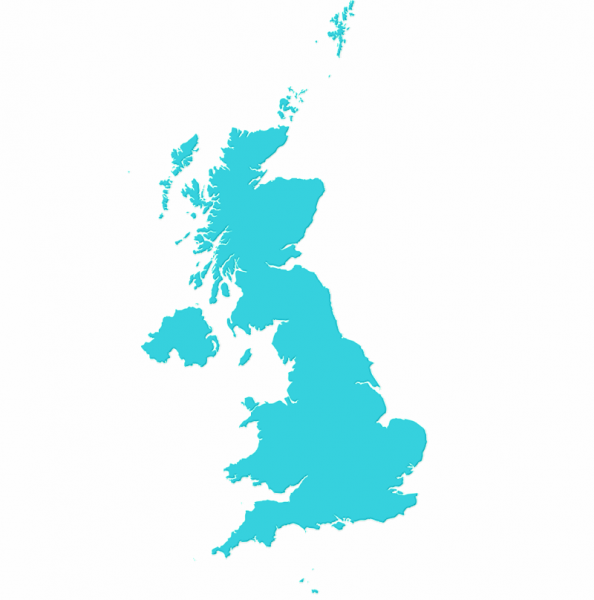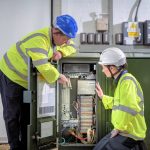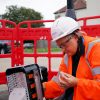2020 H1 – UK Gigabit Broadband Covers 22% as FTTP Hits 14.8%

The latest independent model has estimated that the H1 2020 coverage of “full fibre” (FTTP) broadband ISP networks across the UK has risen to 14.8% of premises (up from 11% in H2 2019), while 61.7% can get 100Mbps+ (up from 59.3%) and 22.1% are within reach of “gigabit” (1Gbps) speeds.
Just for context, it’s important to highlight that the first c.76% of “superfast” (30Mbps+) network coverage was largely achieved by commercial roll-outs from Openreach (BT) and Virgin Media (plus some alternative network ISPs), while much of the final 24% has benefited from £1.8bn of public funding via the Building Digital UK project and other schemes (often matched by contributions from private operators).
The original state aid fuelled BDUK scheme has previously indicated that a combination of public funding reinvestment (i.e. clawback / gainshare from high take-up and efficiency savings in earlier BDUK deployments) and new contracts could push UK coverage of superfast speeds to “at least” 98%, but for now we’re still stuck at about 96.4% (96.7% if using the older 24Mbps+ measure). You have to order one of these services in order to benefit (not an automatic upgrade).
Advertisement
As usual that means the remaining gap is left to be filled by the Government’s 10Mbps Universal Service Obligation (USO), which went live a few months ago. Most people taking the USO are being promised speeds of above 10Mbps but a lot of people are already finding that they live in areas where not even the USO can cover the huge upgrade costs involved (and 4G isn’t available), which means they aren’t able to benefit.
More recently the UK Government has committed £5bn to support a future “gigabit-capable” broadband roll-out to the final 20% of hardest to reach UK premises (here), although this means that some premises will be stuck on slow connectivity for a few years longer (the somewhat over-optimistic ambition is to make such connections available to every home by the end of 2025). This is the first time that we’ve included a figure for gigabit services below, thus there’s no history tracking.
Nevertheless, a growing number of FTTP providers are making significant roll-out plans (details) and as such we expect to see a rapid increase in coverage over the next decade. Below you can see the latest modelling from Thinkbroadband to July 2020 (H1) and as usual we’ve stripped out some of the more confusing aspects in order to make it easier to read.
Fixed Broadband Network Availability 2020 H1
Advertisement
| Area | 30Mbps+ | 100Mbps+ | Full Fibre |
Gigabit | % Under 10Mbps |
| England | 96.9% (96.7%) | 64.1% (61.83%) | 14.06% (10.54%) | 21.95% | 1% (2.09%) |
| UK | 96.4% (96.1%) | 61.7% (59.30%) | 14.81% (11.01%) | 22.12% |
1.5% (2.49%) |
| Wales | 95.1% (94.9%) | 39.9% (38.35%) | 14.11% (11.28%) | 14.11% | 2.5% (3.43%) |
| Scotland | 94.3% (94%) | 52.9% (49.89%) | 12.04% (7.77%) | 20.67% | 3.2% (4.38%) |
| Northern Ireland | 89.1% (89%) | 58% (49.74%) | 47.7% (35.42%) | 47.7% | 6.9% (6.63%) |
NOTE 1: Nearly all of the “ultrafast” (100Mbps+) coverage is coming from Virgin Media’s cable network, although Openreach, Hyperoptic, Gigaclear, Cityfibre, TrueSpeed and others all have big “full fibre” (FTTP/H) expansion plans. The 330Mbps capable G.fast roll-out to 2.8 million UK premises has had a small impact too.
NOTE 2: It’s very important to remember that Government / political targets like 95% reflect a national average, which can of course be better or worse for some regions (e.g. a few may achieve universal coverage, while others could be well below that).
NOTE 3: The 10Mbps USO figure above looks at fixed broadband services but doesn’t factor the impact of 4G or 5G based mobile broadband, if that were included then the gap left to fill would be much smaller (example).
Naturally the coverage of “superfast” networks has slowed as the roll-out moves to tackle more challenging rural areas, while “full fibre” is growing at a much more rapid pace due to the current focus on that technology in largely urban areas (we expect a fair bit of overbuild in such locations and hence why the ‘ultrafast‘ figure doesn’t rise quite as fast).
In terms of future “gigabit-capable” coverage you should probably be looking toward the “ultrafast” figure as a guide because nearly all networks in that class will soon be able to deliver speeds of 1Gbps (except G.fast but gigabit capable networks are already overbuilding some of that). At present Virgin Media delivers most of the ultrafast coverage but their DOCSIS 3.1 will make 1Gbps possible by the end of 2021.
Take note that each devolved region has its own policy and targets, which all feed into the central UK target. Interestingly while Northern Ireland may be struggling to deliver superfast speeds, their full fibre coverage is way ahead of other areas.
As stated earlier, this data is an estimate and should be taken with a pinch of salt, not least because it won’t always reflect the real-world. But it’s still one of the best gauges that we have for checking against official claims (official figures tend to be a tiny bit higher than TBB’s due to differences in data modelling etc.).
Advertisement
Mark is a professional technology writer, IT consultant and computer engineer from Dorset (England), he also founded ISPreview in 1999 and enjoys analysing the latest telecoms and broadband developments. Find me on X (Twitter), Mastodon, Facebook, BlueSky, Threads.net and Linkedin.
« ISP Hyperoptic Donates IT Kit to Help Low-Income Households
South West ISP Jurassic Fibre Refresh FTTP Broadband Plans »























































Meanwhile in Ipswich…
Ipswich is a CityFibre build location
If Cityfibre are there….Expect an unannounced Openreach build to start soon.
@Gary
Wish I could get a fake announcement that an altnet would come to my area, I expect OR would swoop in then and give us something better than just up to 80 of which I get 25.
Meanwhile here in Tendring I have a DL speed of ~18Mbps and UL speed of ~4Mbps – https://www.speedtest.net/result/9720550223.png
Thats way better than many who are yet to see the improvements you have had.
I can only dream of such high speeds – living in Somerset means a complete inability to work from home with erratic maximum 5 Mbps download. Got quoted £18144 for a better connection under the USO scheme. Parliament was sold a pup.
@ChrisMay – 5 mbps?? We dream of 5mbps in the Highlands with barely 0.3! 🙂
And USO costs of £1.1m
I ditched FTTC for 4G, well worth it.
@Mike Ouch, really shows the limitations of the FTTC method, I Ditched out ADSL for 4G last year as we were too far away to get any boost from the FTTC install that went in at the nearest village.
Mark – Any Full Fiber providers coming to Luton ?
Apart from Virgin Media. I’m look for FTTP in luton. I know BT have started FTTP down the road in St Albans its in progress.
I be interested in knowing if any other full fibre providers have plans to compete with Virgin Media in the Luton, Leagrave and Dunstable triangle.
Must be nice to have the option of a 500mb service.
I am stuck on 25/4 with no change in sight.
Also Worth mentioning the Openreach effectively blocked alot of improvements from happening by ineffectively managing their own rollout. We were “in scope” for nearly 5 years before they got round actually carrying out a survey. Which concluded that an upgrade to our network for uneconomical (e.g. they wouldn’t make any money!!)
Due to their slow dim witted approach we’ve now missed 3 phases of the local authorities upgrade scheme’s because we were due to be upgraded my Openreach.
U.S.O. is barely any better almost no-one qualifies due to the 4g aspect because of the wording essentially even if you can only get 10mb between 3 & 4 Am on a Sunday morning but the rest of the time you get average speeds half of that you won’t qualify. So in essence in fails to do anything that it initially set out to do.
In essence if you are one of the few remaining properties not serviced by a decent connection don’t hold your breath you’re not gonna get one . At least untill technology provides a cheaper option for providers e.g. low orbit satellites but unless the provide true unlimited data packages which will probably take years you’re likely to be stuck with a choice between decent speeds or a useable data limit.
When Mark says “a rapid increase in coverage in the next decade” I read “you might get a decent connection in about a decade”.
Still hope I’m wrong but likely I’m realistic
I live on a massive, brand new housing estate, built from the ground up in the last 10 years. They didn’t put any planning into the internet at all, we all fight over space on the exchange to get 10-30Mb speeds.
It must be so much cheaper to lay cables in the house building stages, why is it not a law to have gigabit on all new houses now? It should be up there with running water and electricity.
Newbuilds really shouldnt be an issue these days with the way things have changed re provision of phone/Fibre by Openreach. Sadly later on even when developers should/could have known better they still went with the cheapest option.
How much double or treble counting is going on? Years ago Nynex installed cable ducts in our area. When Nynex went bust Virgin took the cable system over. Eventually Virgin dumped any customer who wouldn’t move over to its cable system for Broadband. Then Openreach spent the last couple of years installing fibre to the top of all their poles making FTTP available. Now a third company has started erecting poles for fibre Broadband. Do we get counted three times? Is there a market for three competing systems? Wouldn’t it be more sensible to share the infrastructure and spend the money on providing fast Broadband to those parts of the country who don’t already have it?
Double and treble counting is taken into account, i.e. if you have three FTTP providers infrastructure you still only count as 1 property passed by fttp.
Your property only gets counted once.
Different companies build different things. Openreach’s network and anything built with public money has to be built from the outset in a way that it can be wholesaled to ISPs to run their services over. Privately funded networks don’t and so preventing overbuild would serve to give a monopoly to whoever got somewhere first. If that ISP has high prices or poor service or both, tough.
If network builders agreed amongst themselves to avoid overbuild
It would be cartel behaviour directly in contravention of the competition act and people would go to prison.
My area of Peterlee is just rolling out youfibre
Up to 1000Mbps for £30 per month for the first year
Happy chappy
Still no provision for upload speeds then. We have Vigin’s “ultrafast” 100Mbps+, but only 10Mbps upload. Not really adequate for two of us to work from home in the jobs (engineering) we do. A satellite system for download with upload going via a 1kbps link could meet ultrafast under this definition!
Hopefully with more working from home, people will realise upload is important. Although, I imagine many don’t realise the difference. Or never thought they really needed much. Virgin know this, and likely save loads by limiting upload and advertising large download speeds. (We would switch provider if our BT line was up to standard.)
why don’t you just upgrade to M200, double the speed in both directions.
@Roger_Gooner: According to VM, even the M200 package has no more than 20Mbps average upload speed. In many cases, VM isn’t useful for professional users!